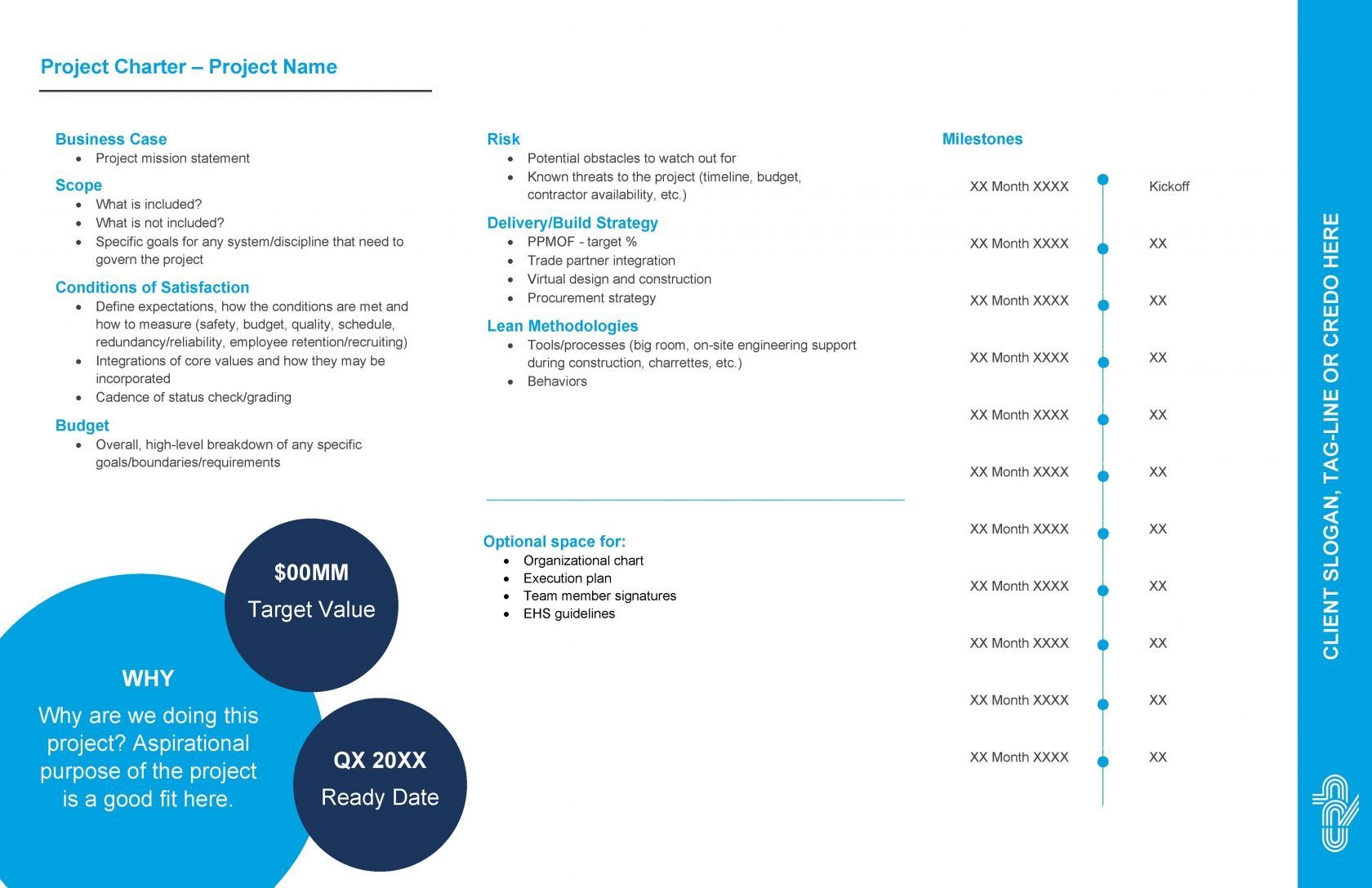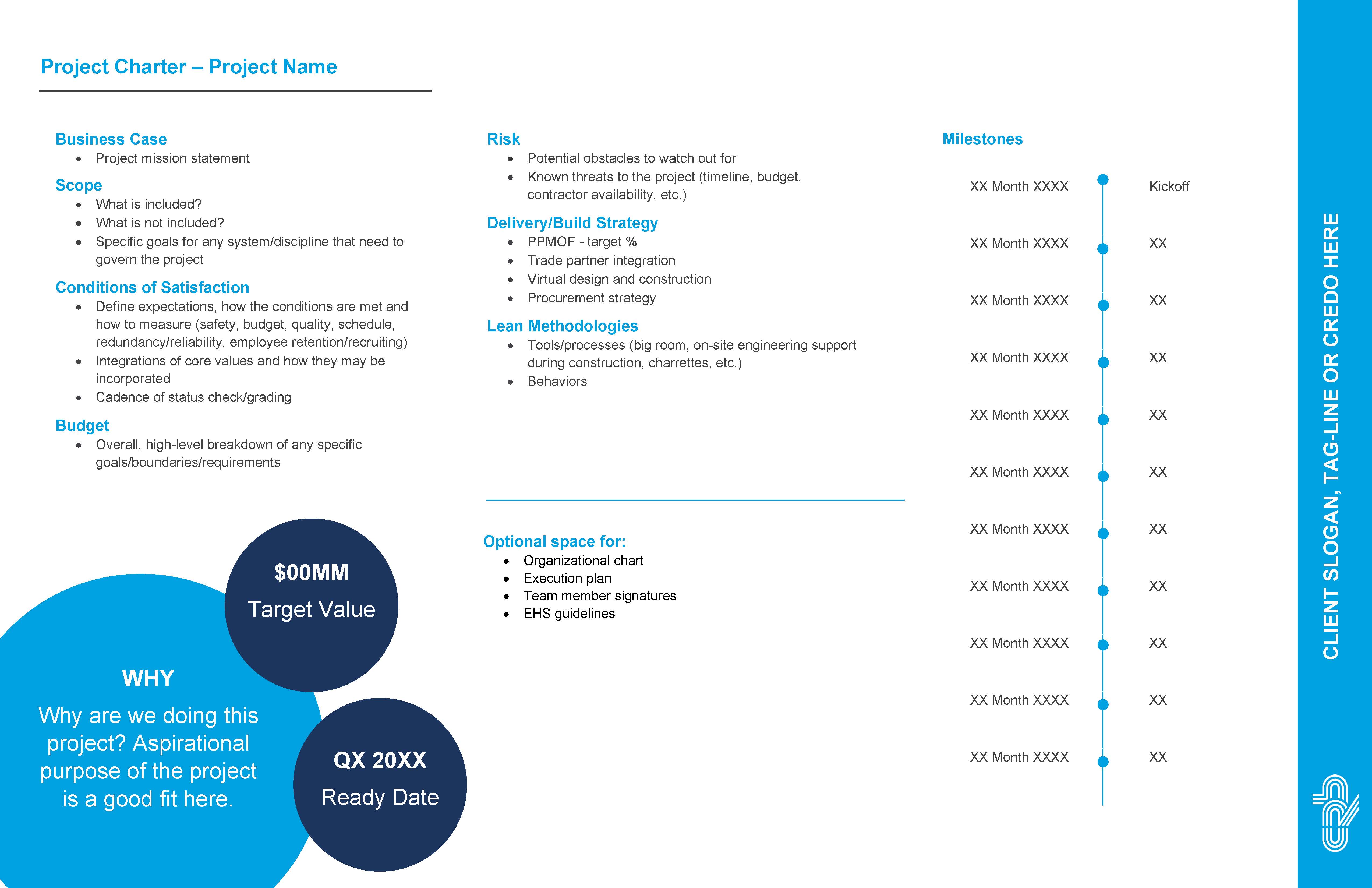
A project charter turns a collection of people into a team, and a series of tasks into a unified purpose.
The notion of moving at “warp speed” may have strong associations with pharma, but project owners across all industries—from food and beverage to science and tech—are under pressure to design and deliver capital projects incredibly quickly. Avoiding costly mistakes while moving that fast is difficult under any circumstances, but without strong and early alignment between all team members, it’s nearly impossible. By establishing a project charter early in the delivery cycle, you’re establishing the conditions necessary to succeed, even—and especially—under tremendous pressure and at great speed.
In this article:
- What is a project charter?
- Why should you make a project charter?
- When should you make a project charter?
- Who should be involved in the chartering process?
- How should you make a project charter?
- Are some projects more suited to a charter than others?
What is a project charter?
A project charter is a one- or two-page document, co-developed by the project owner, the AEC firms and their trade partners to clarify the project’s business case, lay out its conditions of satisfaction, define its target value, establish major milestones and identify key stakeholders.
A project charter defines concrete objectives such as schedule, target value, and build strategy. It also establishes more subjective conditions of satisfaction and outlines the values that team members will rely on as they work to achieve shared project goals. It should be short enough to post on the wall, but detailed enough to maintain alignment between all members of the integrated project team.
It’s not only a document, though. To make a strong project charter, stakeholders from across the team must engage openly with each other, having conversations that they may not have had otherwise and establishing important criteria that might have gone overlooked. This process helps the team to develop trust, facilitate communication, and establish a culture of shared ownership. It’s a piece of paper—and it’s also a process.
Why should you make a project charter?
A project charter encourages key stakeholders to align on shared goals.
It’s not unusual for stakeholders to launch a project without discussing its WHAT and WHEN as a group. In the absence of these discussions, individual assumptions drive important decisions. For example, a project manager may focus on cost and scheduling objectives, a manufacturing engineer on liters-per-year throughput, and a maintenance manager on the ability to easily replace tank agitators and/or pumps. The push-and-pull between these priorities can cause distraction and a lack of focus on the project team.
The chartering process solves this challenge. It brings key stakeholders together early in the process and encourages open and honest conversations about the project’s goals and conditions of satisfaction (CoS). As a result of these conversations, all team members are able to move forward with a common understanding of the project’s WHAT, WHEN, WHY, HOW, and HOW MUCH. Instead of spending time seeking alignment late in the delivery lifecycle, team members can stay focused on the tasks at hand, confident that they’re all moving in the same direction.
The project chartering process helps to build a cohesive project team.
On a large, integrated project team that includes owners, architects, engineers, construction managers, trade partners, and suppliers, chances are good that most people haven’t worked together before—and yet their cooperation is key to a project’s success.
The chartering process makes that cooperation possible. It’s a highly interactive experience designed to build relationships between all team members that are based on trust, honesty, and open communication. This positive team culture, established during the chartering phase, continues to evolve throughout the project lifecycle, resulting in a constant feedback loop that encourages collaboration and shared accountability.
A project charter enables early cost and schedule certainty.
During the chartering process, stakeholders establish the scope and schedule, using input from across the integrated project team.
The key here is that the people making cost and schedule commitments are the same people who will do the work. This is a stark difference from more traditional approaches in which the AE/CM makes commitments based on their past experience, without input from the trade partners who will have to deliver on those commitments. Onboarding those trade partners during the chartering process and involving them in fundamental decisions about the project is essential to building more certainty into the estimate and schedule.
A project charter puts the right tools in place, right away.
In addition to establishing big-picture objectives like cost and scheduling, the chartering process clarifies how a project team will meet those objectives. What strategies will the team put in place? What tools will they leverage? Establishing early alignment on these project execution strategies and tools means the team can hit the ground running.
When should you make a project charter?
The chartering phase should start with the project kick-off, and it should conclude within the first 15% of the project schedule.
At CRB, we begin the chartering phase at our first meeting, where we work alongside our client to understand the project’s business case. The chartering process continues until the whole project team is aligned on key objectives, scope, target cost, and other charter fundamentals.
On very simple projects, the chartering phase might occupy a single afternoon. More typically, it involves a series of workshops that take place over several days or weeks.
Project chartering starts with the business case and ends with a target value and scope alignment.
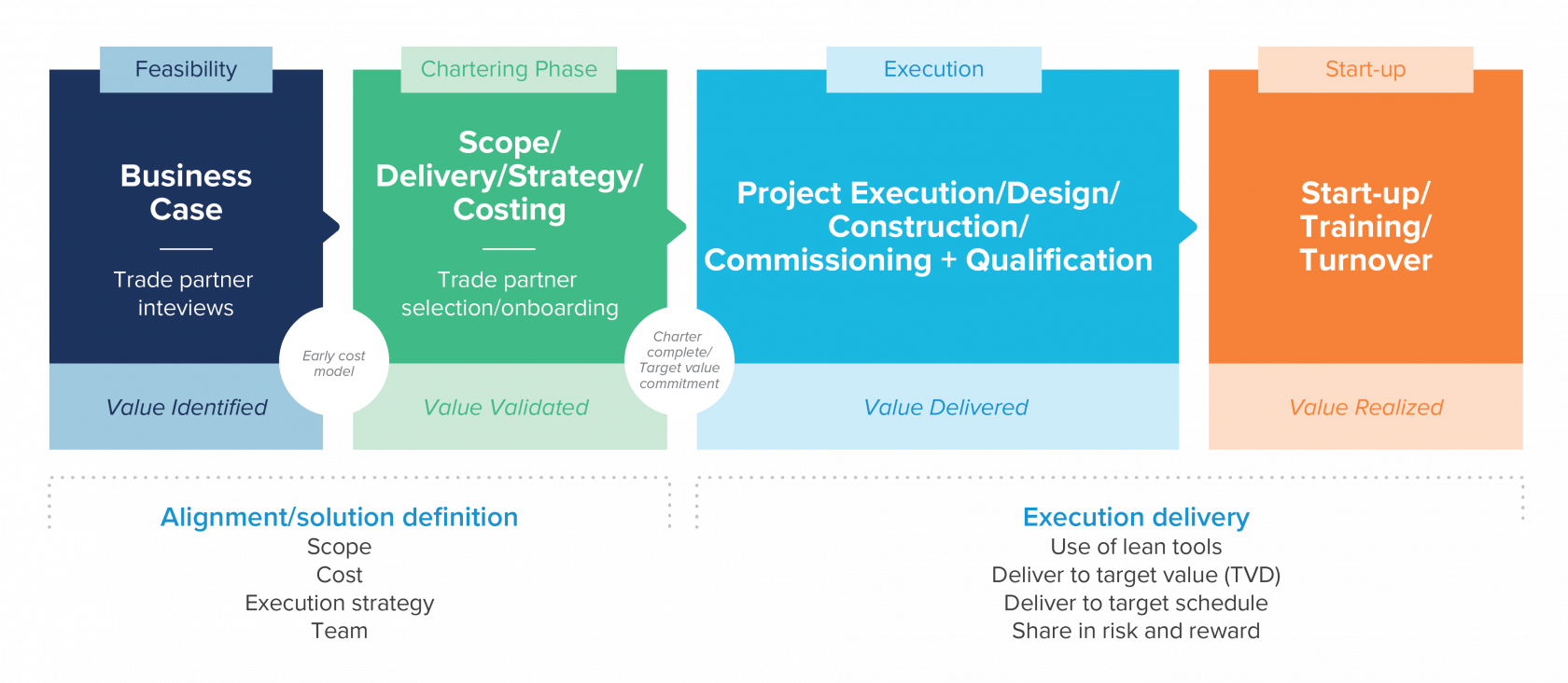
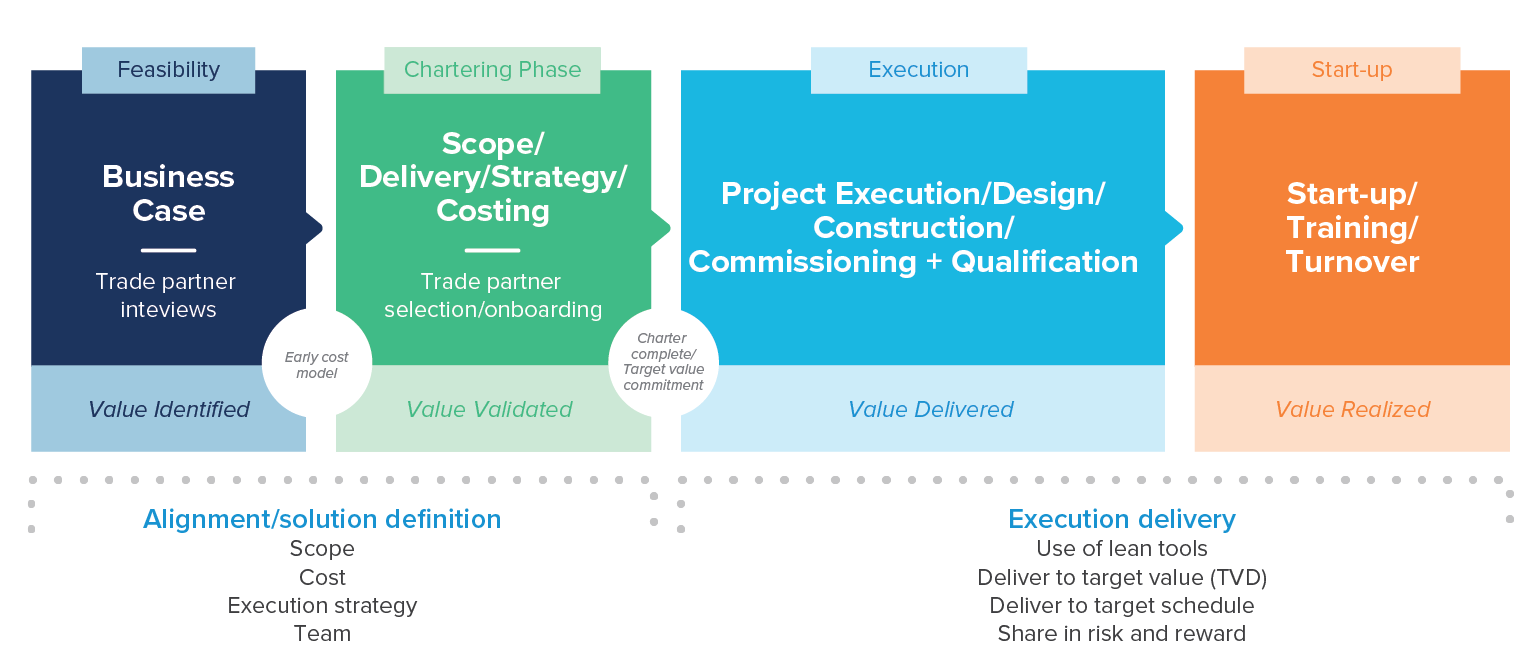
The project chartering process may have a beginning and an end, but the charter itself does not.
Teams should post their project charter in high-traffic areas on the jobsite. Throughout the project’s lifecycle, this document provides both a yardstick for measuring progress and an incentive for maintaining accountability. As team members hit project milestones or meet other KPIs, the charter is also an important reminder to recognize progress and celebrate success.
Who should be involved in the project chartering process?
The list of stakeholders involved will depend on the project’s complexity. At minimum, it ought to include those accountable to the project’s objectives.
Broad engagement from the client stakeholders is critical, including executive management, project management, engineering, manufacturing, maintenance and quality. Representatives from the AE, CM, key trade partners and equipment suppliers are also essential participants. This integrated team will help to right-size and validate the solutions and strategies outlined in the charter.
Many project owners will find it useful to include AEC partners (architecture, engineering and construction) with first-hand experience of building effective project charters. That way, you can focus on the content of your charter, while an expert focuses on facilitating the overall experience and integrating the perspectives of all involved.
A good project charter integrates the perspectives and expertise of multiple stakeholders.

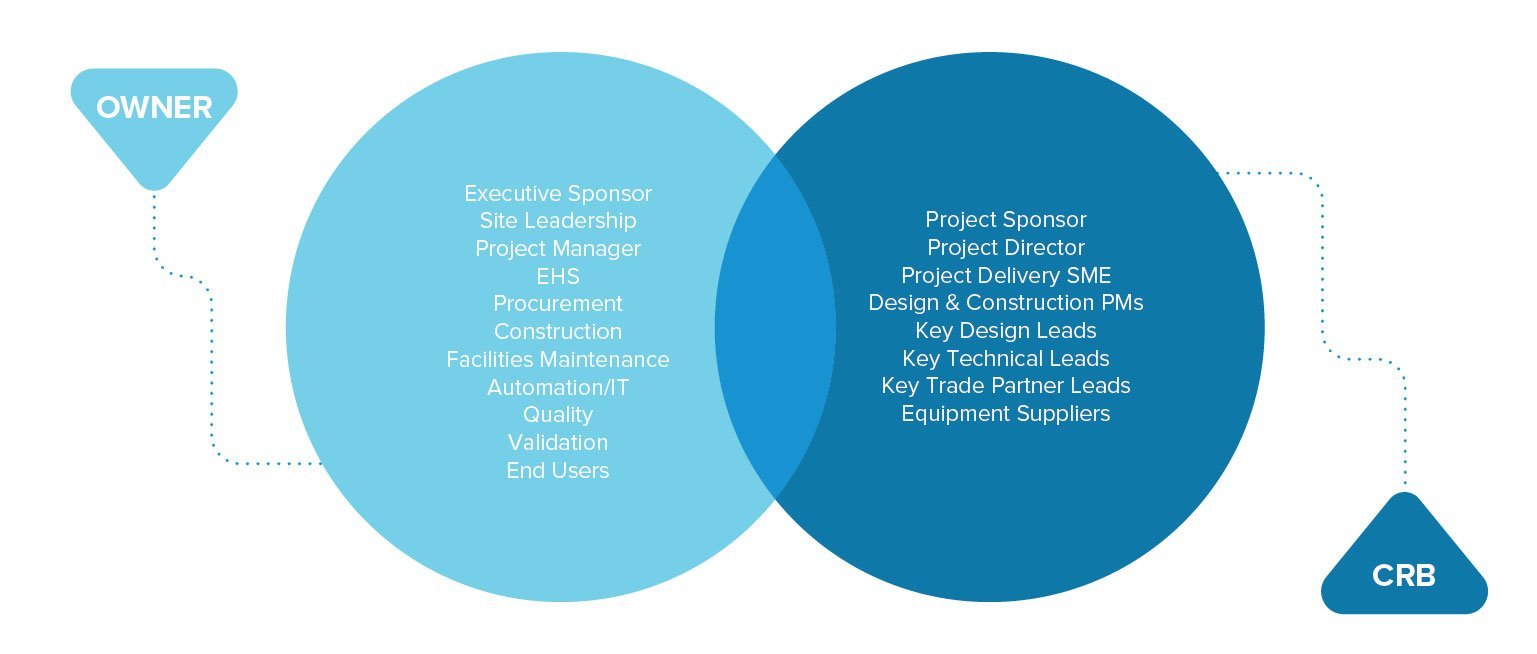
How should you make a project charter?
The project chartering process is, by design, a flexible one. Its facilitators can expand or shrink the scope of that process according to the nature of the project, the number of stakeholders involved, the complexity of the business case, or any other variables.
What matters most is the end result: a charter that accurately and succinctly represents the specific objectives and conditions of satisfaction for the project in question. Getting to that result will require a tailored combination of several workshops or strategy sessions, such as:
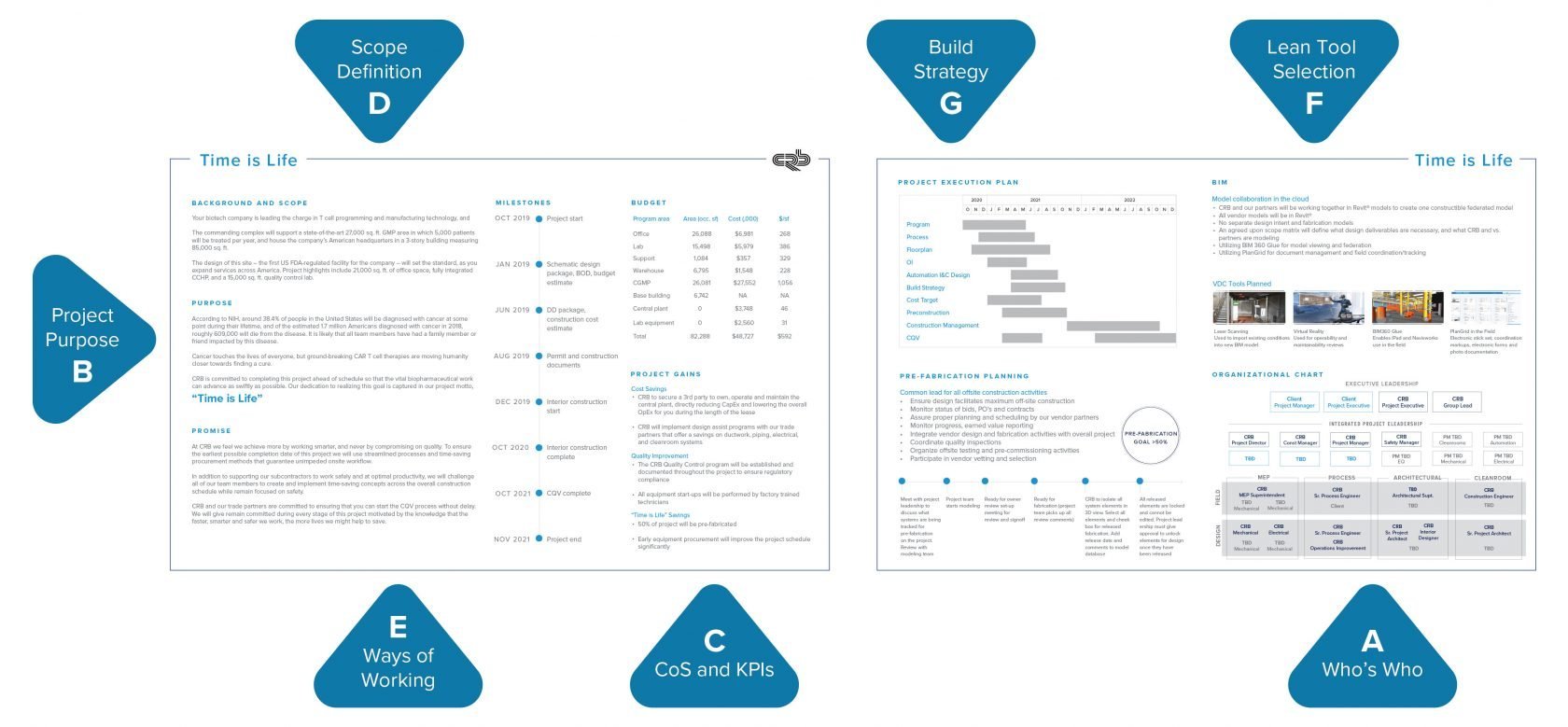
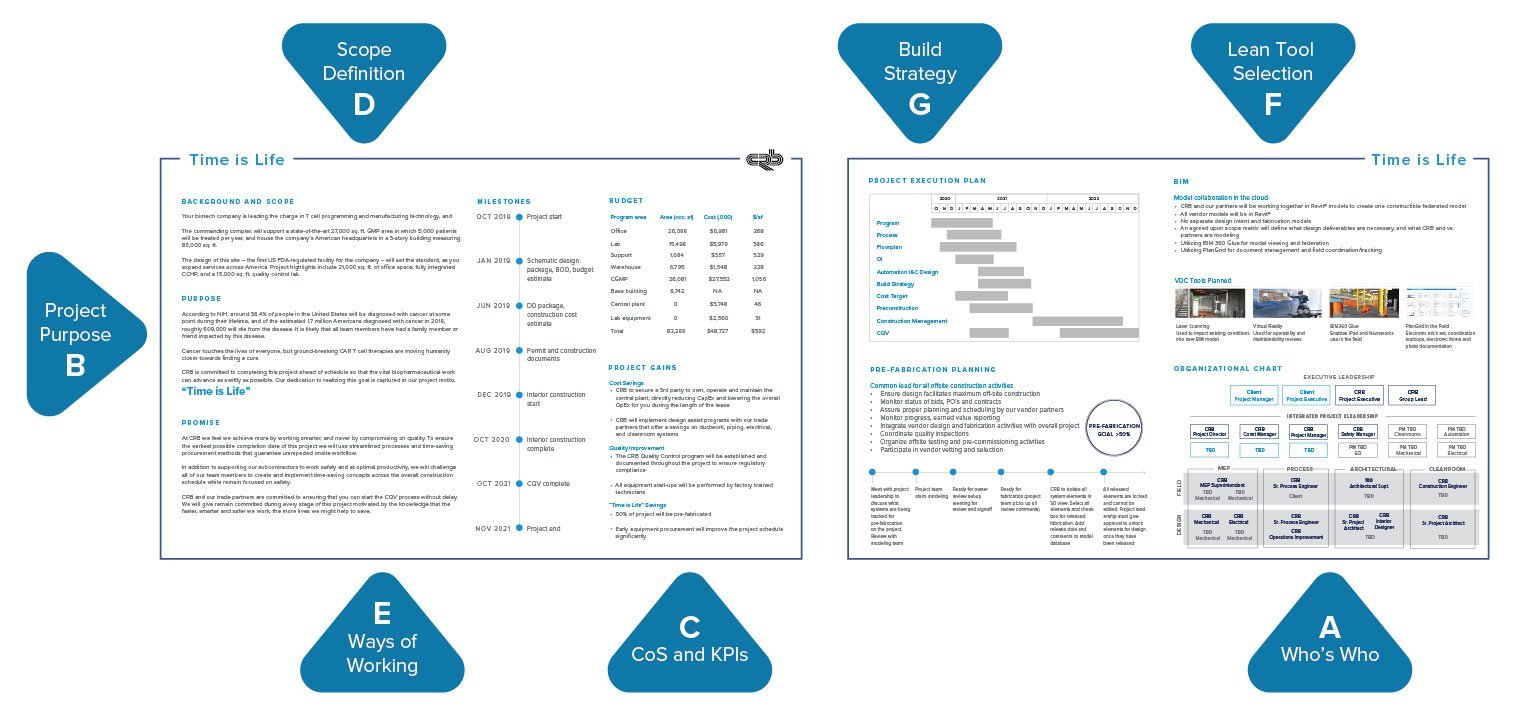
Who’s who
Every project charter should identify key stakeholders and establish a distributed leadership structure to oversee the integrated project team.
Project purpose
It’s important for every project charter to communicate what the project means to the team, to the client, and/or to the end consumer.
For example, the purpose behind a new manufacturing facility for alternative proteins might focus on sustainability and environmental stewardship; a cell and gene therapy lab might cite cancer statistics in its purpose, and promise to accelerate the development of curative therapies.
Although it’s just a few lines long, this “purpose statement” should be crafted with great care. It’s the WHY behind the project, and will help team members to motivate themselves and one another as the project progresses.
Conditions of satisfaction and key performance indicators
Not every team will define success the same way. Even within the same team, different stakeholders may measure success using different criteria.
By discussing these criteria and establishing a shared set of CoS—and by attaching those CoS to KPIs—the project team is in a much better position to make effective decisions, maintain a positive team culture, and collaborate towards a shared vision.
Most project charters include anywhere from three to eight CoS. Some may be objective while others have a more subjective angle. Examples include:
Objective conditions of satisfaction:
- Budget goals (KPI: Target value)
- Scheduling goals (KPI: Project start date, utilities start-up and commissioning date, etc.)
- Manufacturing throughput goals (KPI: Liters per year, etc.)
- Sustainability goals (KPI: LEED Certification, volume of recycled construction materials, etc.)
- Quality goals (KPI: Volume of rework, number of punch list items, etc.)
- Safety goals (KPI: Leading/lagging indicators)
- Award-based goals (KPIs: ISPE Facility of the Year, Food Plant of the Year, safety awards, etc.)
Subjective conditions of satisfaction:
- Team goals (KPI: Team satisfaction)
Scope definition and validation
The project charter’s most important role is to give team members a sense of shared ownership and responsibility towards the project’s success, which requires a clear and well-considered scope.
A robust scoping exercise will call on the expertise of all stakeholders, from project owners through trade partners, to develop and validate project parameters against the business case. With these shared parameters in place, project teams can schedule key milestones with confidence, giving all team members a “big picture” view of which goals they must hit and when.
Ways of working together
Most project teams aren’t really teams at all—they’re more like groups of individuals, thrown together by chance and circumstance. It takes a deliberate effort to turn that group of people into a cohesive and high-performing team, which is a must in today’s world of fast-tracked projects.
A collaborative and trusting environment is essential for teams to work at a high-performing level. Done properly, the “ways of working” discussion will create that environment, which in turn will reduce conflicts that create costly delays and promote a productive culture of shared risk/shared reward.
Lean tool selection
Instead of identifying and onboarding tools as they become necessary, the chartering process invites project owners to proactively seek out the tools that will help them to meet their objectives. This avoids downstream bottlenecks by ensuring that all team members know in advance what each tool is for, why it’s important, and how to use it.
Lean tools might include:
- A Big Room: A central location, often at the jobsite, where client representatives, project designers, construction managers, trade partners, and other stakeholders work next to one another.
- Target value delivery (TVD): The central premise of TVD is that “cost is an input to design.” Rather than reacting to project overruns with a value engineering exercise, TVD lays the groundwork for proactive, ongoing budget alignment.
- Last PlannerⓇ System/Pull Planning: An collaborative approach to project management in which the people scheduling tasks and making commitments to the team are the same people responsible for doing the work.
- A3 Problem Solving: A simple, structured approach to resolving uncertainty and making effective and collaborative project decisions using a single, A3 report.
Build strategy
Just as the project chartering process accelerates lean tool selection, it also accelerates and prioritizes decision-making related to the project’s build strategy. By providing stakeholders with a holistic understanding of the project’s scope, cost, and scheduling considerations, the chartering process gives them an opportunity to align this strategy with their objectives.
“Build strategy” is a term that encompasses several possible contributing elements, including:
- Strategy for assessing and selecting project partners
- PPMOF strategy (prefabrication, preassembly, modularization and offsite fabrication)
- Virtual design and construction strategy
- Takt time planning
- Procurement and contract strategy
- Commissioning, qualification and automation strategy
Are some projects more suited to a charter than others?
A charter adds value to projects of every size, in every market, using every type of delivery approach, from traditional design-bid-build projects to lean execution strategies. Every one of these projects needs to have the right experts using the right strategies to pursue common goals, and that’s precisely what a charter guarantees.
At CRB, the project chartering process is a key component of our ONEsolution™ approach to integrated project delivery. Whatever the size of a project, it benefits from the flexible tools and expert guidance that are part of ONEsolution—including the project charter. We’ve facilitated the chartering process for projects as simple as equipment installations and as complex as a new, state-of-the-art manufacturing campus. Regardless of scale, all projects benefit greatly from the charter itself, and from the collaborative process behind it.
Ready to launch your own project chartering process?
Getting the project charter right can get you to the finish line more smoothly, quickly, and cost-effectively.
Start your chartering process by downloading our project charter template, then reach out to our team of experts for tailored advice about turning this template into a road map for success.

